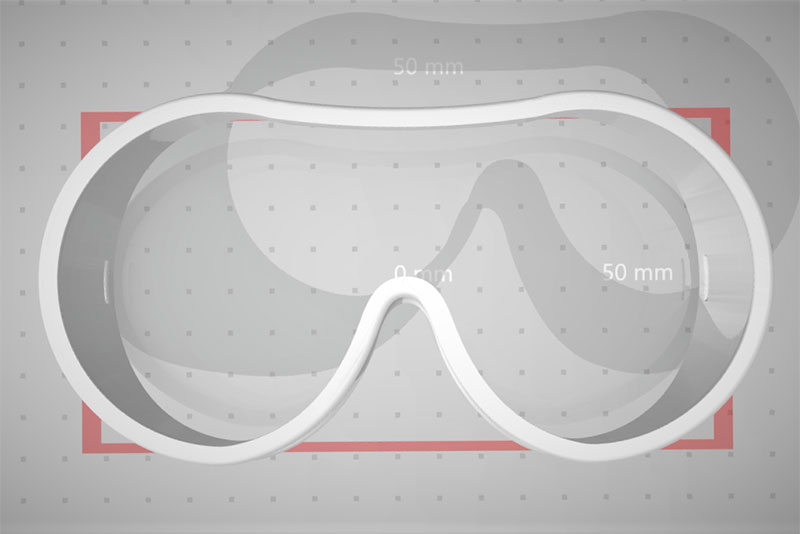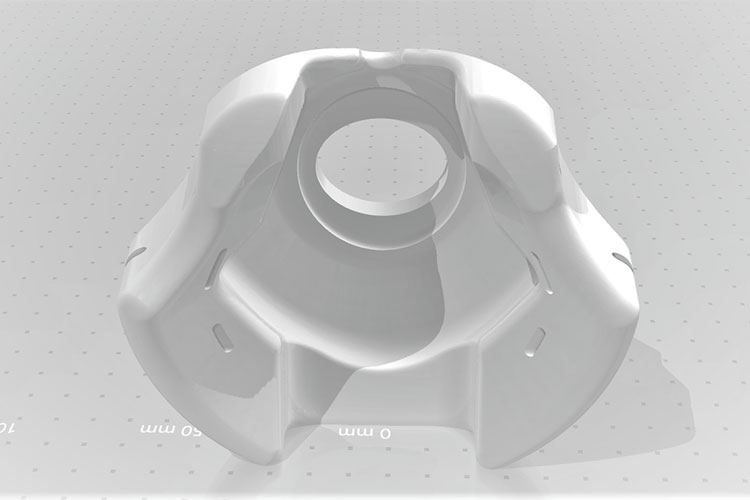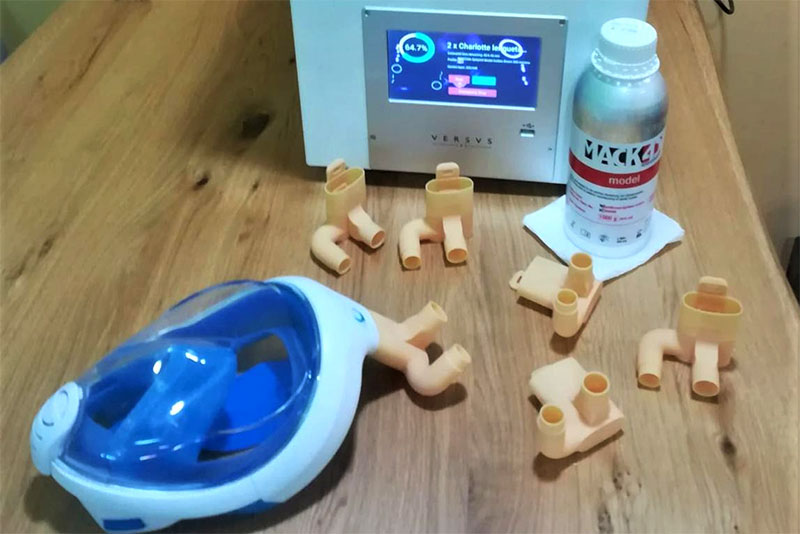3D Printer Template Goggles
€0.00*
Frequently asked questions about TIKO-G Castable Resin
Who is Castable Resin suitable for?
TIKO-G Castable Resin allows you to create high quality jewelry creations without much effort through flexible burnout and casting processes. From sophisticated bridal accessories to intricate designer jewelry, Castable Resin can be used to print highly detailed jewelry pieces. Low expansion, compatibility with industry-leading investment materials and residue-free burnout make TIKO-G Castable Resin particularly attractive to jewelers. The casting process and short curing time without post-curing also speeds up and simplifies the workflow. This makes TIKO-G Castable Resin the ideal material for your jewelry business. Whether you are a beginner or advanced, a mass producer or a craftsman, TIKO-G Castable Resin makes the production of 3D printed jewelry easier and more efficient.
How do goldsmiths use resin?
With powerful equipment and materials, designers and manufacturers are saving time traditionally spent manually preparing jewelry. With cost-effective, intuitive desktop 3D printing capabilities like the Formlabs Form 2, high-quality 3D printing is becoming increasingly affordable and scalable for jewelers. Highly detailed jewelry is known to require painstaking and time-consuming manual labor. But in our fast-paced world of high demand and short-lived trends, jewelry made by hand can usually struggle to keep up. The development of castable resin now enables first-class manufacturing on affordable 3D printers. It combines exceptionally high strength with a smooth surface finish. The precise print settings capture even the smallest detail. Subtleties such as filigree wires, meshes or pavé settings are highlighted and precisely captured. Castable resin with a wax content of over 25 percent enables very clean casting and reliable burnout. It is suitable for standard burnout schedules on the one hand and for shortened eight-hour burnout schedules on the other. The resins developed by TIKO-G for investment casting and jewelry making reproduce fine detail and and allow for custom jewelry pieces at an affordable price. Castable resin is therefore more in demand than ever throughout the manufacturing process for goldsmiths, jewelry designers and jewelers.
At what temperature does the resin melt?
Castable resin does not melt. Instead, sublimation begins at 130 degrees Celsius. Sublimation is the term used to describe the transition process of a solid material into the gas phase. The recommended burnout schedule is designed to allow Castable Resin to slowly transition to the gaseous state. The gradual sublimation prevents the rapid expansion of the printed part so that no cracks form in the investment material.
What is castable resin used for?
Castable resin is used for casting filigree jewelry, among other things. Both detailed and voluminous models can be easily printed with Castable Resin. The simplified and accelerated burnout and direct investment casting process without post-curing allows you to finish with only minimal effort. Castable Resin printed parts are strong enough and suitable for both prototyping and fitting before actual production. You can use TIKO-G Castable Resin for the following:
All jewelry models
Jewelry with intricate details, thin walls, pavé settings and fine surface details
Larger castable parts
Prototype production
Jewelry customization
How much Castable Resin do you need?
To determine the amount of Castable Resin you need, you can use the following formula as a guide:
Length x width x height x density
The exact density can be found in the product data sheet, whereby the guide value is about 1.2 g/cm³.
.btn-flyer-download {
transition-duration: 0.4s;
}
.btn-flyer-download:hover {
background-color: #b30000;
color: white;
}
.btn-flyer-download{
background-color: #4CAF50; /* Green */
border: none;
color: white;
padding: 10px 40px;
text-align: center;
text-decoration: none;
display: inline-block;
font-size: 16px;
border-radius: 8px;
text-align:left;
background-color: red;
}
.column {
float: left;
width: 25%;
padding: 10px;
height: 300px; /* Should be removed. Only for demonstration */
text-align:center;
background-color: transparent;
}
/* Clear floats after the columns */
.row:after {
content: "";
display: table;
clear: both;
background-color: transparent;
}
.dot {
height: 55px;
width: 55px;
text-align: center;
display: inline-block;
background-image:url('/media/98/e5/7f/1632732860/1.png');
}
@media screen and (max-width: 648px) {
.column {
width: 50%;
height: 250px;
}
@media screen and (max-width: 330px) {
.column {
width: 100%;
height: 240px;
}}
/* Three image containers (use 25% for four, and 50% for two, etc) */
.column1 {
float: left;
width: 33.33%;
padding-left: 9%;
padding-right:9%;
padding-top:2%;
padding-bottom:2%;
margin:auto;
text-align:center;
align:center;
}
/* Clear floats after image containers */
.row1::after {
content: "";
clear: both;
display: table;
}
@media screen and (max-width: 600px) {
.column1 {
width: 100%;
padding-left: 8%;
padding-right:8%;
padding-top:2%;
padding-bottom:2%;
}
.columnreview {
float: left;
width: 25%;
padding: 10px;
height: 345px; /* Should be removed. Only for demonstration */
text-align:left;
background-color: white;
}
img {
float: left;
width: 100%;
height: auto; /* Should be removed. Only for demonstration */
text-align:center;
background-color: white;
}
/* Clear floats after the columns */
.row2:after {
content: "";
display: table;
clear: both;
background-color: white;
}
@media screen and (max-width: 648px) {
.columnreview {
width: 50%;
height: 255px;
}
@media screen and (max-width: 500px) {
.columnreview {
width: 50%;
height: 270px;
}
@media screen and (max-width: 420px) {
.columnreview {
width: 50%;
height: 315px;
}
.banner5{
width:100%;
overflow:hidden;
height:100%;
background-color:#FF9A9A;
}
.beratungzumprodukt {
transition-duration: 0.4s;
}
.beratungzumprodukt:hover {
background-color: #b30000;
color: white;
}
.beratungzumprodukt{
background-color: #4CAF50; /* Green */
border: none;
color: white;
padding: 10px 40px;
text-align: center;
text-decoration: none;
display: inline-block;
font-size: 16px;
border-radius: 8px;
text-align:left;
background-color: red;
}
.column2 {
float: left;
width: 20%;
padding: 10px;
height: 290px; /* Should be removed. Only for demonstration */
text-align:left;
background-color:#FF9A9A;
}
.column3 {
float: left;
width: 30%;
padding: 10px;
height: 290px; /* Should be removed. Only for demonstration */
text-align:left;
background-color:#FF9A9A;
}
.column4 {
float: left;
width: 30%;
padding: 10px;
height: 30px; /* Should be removed. Only for demonstration */
text-align:left;
background-color:#FF9A9A;
}
/* Clear floats after the columns */
.row:after {
content: "";
display: table;
clear: both;
}
@media screen and (min-width: 706px) and (max-width: 976px) {
.column2 {
float: left;
width: 5%;
padding: 10px;
height: 280px;
text-align:left;
background-color:#FF9A9A;
}
.column3 {
float: left;
width: 55%;
padding: 10px;
height: 280px;
text-align:left;
background-color:#FF9A9A;
}
.column4 {
float: left;
width: 32%;
padding: 10px;
height: 20px; /* Should be removed. Only for demonstration */
text-align:left;
background-color:#FF9A9A;
}
}
@media screen and (min-width: 706px) and (max-width: 10976px) {
.banner5{
display:block;
}
.column3{
display:block;
}
.column4{
display:block;
}
.imgcolumn4{
display:block;
}
.spaceinbetween{
display:block;
}
.banner9{
display:none;
}
}
@media screen and (min-width: 0px) and (max-width: 705px) {
.banner5{
display:none;
}
.column3{
display:none;
}
.column4{
display:none;
}
.imgcolumn4{
display:none;
}
.spaceinbetween{
display:none;
}
}
@media screen and (min-width: 0px) and (max-width: 10703px) {
.banner8 { display: none; } /* show it on small screens */
}
@media screen and (min-width: 0px) and (max-width: 705px) {
.banner9 { display: block; } /* show it on small screens */
}
@media screen and (min-width: 0px) and (max-width: 705px) {
.banner8space { display: block; } /* show it on small screens */
}
@media screen and (min-width: 706px) and (max-width: 10698px) {
.banner8space { display: none; } /* show it on small screens */
}
@media screen and (min-width: 0px) and (max-width: 648px) {
.banner9spacebetween { display: block; } /* show it on small screens */
}
@media screen and (min-width: 649px) and (max-width: 10648px) {
.banner9spacebetween { display: none; } /* show it on small screens */
}
.banner8 {
align:center;
text-align:center;
background-color:#FF9A9A;
}
.beratungzumproduktt {
transition-duration: 0.4s;
}
.beratungzumproduktt:hover {
background-color: #b30000;
color: white;
}
.beratungzumproduktt{
background-color: #4CAF50; /* Green */
border: none;
color: white;
padding: 10px 40px;
text-align: center;
text-decoration: none;
display: inline-block;
font-size: 16px;
border-radius: 8px;
text-align:left;
background-color: red;
}
.wrapper1 {
max-width: 80%;
width: 80%;
margin: 10vh auto;
}
input {
display: none;
}
.label1 {
display: flex;
width: 100%;
height: 40px;
cursor: pointer;
border: 3px solid #3E474F;
user-select: none;
}
.label1 div:first-child {
width: 100%;
line-height: 45px;
margin-left: 10px;
font-size: 1.2em;
}
.cross{
margin-right:15px;
margin-top:3px;
}
.cross:before,.cross:after {
content: '';
border-top: 2px solid #3E474F;
width: 15px;
display: block;
margin-top: 18px;
transition: 0.3s;
}
.cross:after {
transform: rotate(90deg);
margin-top: -2px;
}
.content1 {
box-sizing: border-box;
margin: 10px 10px;
max-height: 0;
overflow: hidden;
transition: max-height, .5s;
}
input:checked ~ .content1 {
max-height: 400px;
transition: max-height, 1s;
}
input:checked ~ label .cross:before {
transform: rotate(180deg);
}
input:checked ~ label .cross:after {
transform: rotate(0deg);
}
.questions{
margin-top:20px;
max-height: 0;
overflow: hidden;
transition: max-height, .5s;
}
.questions label{
border:none;
box-shadow: none;
margin:0;
}
input:checked ~ .questions {
max-height: 400px;
border-bottom:2px solid #3E474F;
transition: 1s;
}
/*----------tool-tip------------*/
.tip {
color: #f03768;
cursor: help;
position: relative;
overflow: visible;
}
.tip:before,
.tip:after {
position: absolute;
opacity: 0;
z-index: -100;
transform: translateY(-30%);
transition: .4s;
}
.tip:before {
content: '';
border-style: solid;
border-width: 0.8em 0.5em 0 0.5em;
border-color: #3E474F transparent transparent transparent;
transform: translateY(-200%);
bottom:90%;
left:50%;
}
.tip:after {
content: attr(data-tip);
background: #3E474F;
color: white;
width: 150px;
padding: 10px;
bottom: 150%;
left: -50%;
}
.tip:hover:before,
.tip:hover:after {
opacity: 1;
z-index: 100;
transform: scaleY(1);
}
@media screen and (min-width: 0px) and (max-width: 575px) {
.wrapper1 { display: none; } /* show it on small screens */
.faqaccordion {
display:block;
}
}
@media screen and (min-width: 576px) and (max-width: 720px) {
.label1 {
display: flex;
width: 100%;
height: 80px;
cursor: pointer;
border: 3px solid #3E474F;
user-select: none;
} }
@media screen and (min-width: 576px) and (max-width: 10648px) {
.wrapper1 { display: block; } /* show it on small screens */
.faqaccordion {
display:none;
}
}
3D Printer Template Mask
€0.00*
3D-Drucker Vorlage:
Verbesserte Filteraufnahme
Verbesserte Filteraufnahme mit Gewinde für unsere Atemschutzmaske.Diese Vorlage wurde uns von einem Benutzer zur Verfügung gestellt. Vielen Dank.
Adapter for emergency mask for hospital ventilators
€0.00*
Our partner Microlay from Madrid in Spain has developed an adapter for the production of emergency masks for hospital respirators, which can be connected to snorkel masks already on the market. You can find more information about the use of the adapter here. Please also be sure to read the instructions and safety regulations for using the emergency mask.



